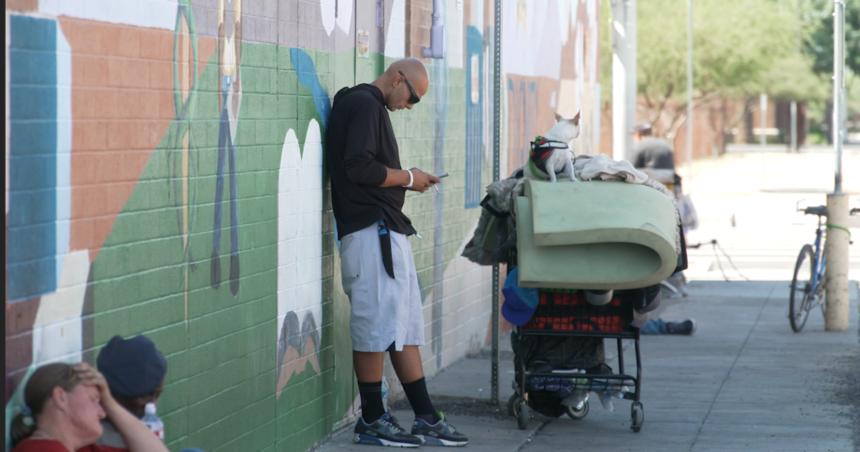On Monday, the National Weather Service announced excessive heat warnings in parts of California with more set to take effect in Phoenix and Las Vegas later this week. The triple-digit temperatures give a glimpse of what summer may have in store following record-breaking heat in 2023 linked to thousands of heat-related deaths in the United States.
June 3, 2024, marked seven back-to-back days of triple-digit heat in Phoenix, and the city is expected to reach 110 degrees by Wednesday, and 113 on Thursday, prompting heat alerts.
Every year, blistering heat bakes the streets of Phoenix, and for homeless people, the lucky ones secure shelter — but often, the waitlists are long.
“I was very fortunate,” Ronald Kalt said.
Kalt is 67 years old. He said he moved into St. Vincent de Paul, a nonprofit in Phoenix, last May after running out of money to pay for hotels and living out of his vehicle for a couple of weeks.
“Housing is ridiculous these days … it’s astronomical,” Kalt said.
The median rent in Phoenix is $1,962, and across the state the average rent in March rose to $1,499, according to Redfin.
Housing affordability has been a central issue as summer inches closer. In 2023, the Maricopa County Justice Courts reported more than 83,000 eviction filings, the second-highest reported in a decade.
Kalt said without government assistance, finding a home on a fixed income is a struggle.
His story highlights the reality many people living in Arizona face.
A homeless count conducted on Jan. 22, 2024, in Maricopa County found 9,435 people experiencing homelessness; 57% were in emergency shelter, transitional housing, or safe haven programs, and 43 % of them were living on the streets.
Kanani Hamman maneuvers her electric wheelchair in an area in downtown Phoenix known as “The Zone.” It was once overrun with nearly 1,000 homeless people who set up tents. The streets have since been cleared, but handfuls of homeless people can still be found in the area, leaning against buildings that provide little shade.
Hamman described the heat as “penetrating, burning.” She carried a tube of sunblock in her wheelchair basket and extra bottled water as she rode through the streets on a hot 100-degree afternoon.
“It’s harder to breathe, it’s harder to move, you have less stamina,” Hamman said.
She has lived in Arizona for years and pointed out that while 100-degree days are not out of the ordinary, the heat can be brutal.
According to data released by the state, between 2012 to 2022, longtime Arizonans accounted for 922 heat-related deaths, or about 85 per year.
As the sun beams down on Phoenix, the streets and sidewalks turn into hot griddles that can be lethal. Experts say the pavement can reach temperatures as high as 180 degrees.
Valleywise Health’s Arizona burn center dubbed the brutal pavement heat “Streets of Fire.” In 2022, 85 patients were hospitalized at Valleywise Health from contact burns during June, July, and August; seven patients died from their injuries.
An analysis by The Associated Press found that in the U.S. during 2023, 2,300 death certificates filed during the summer months mentioned the effects of excessive heat. Arizona recorded a record high for heat-related deaths with 875 fatalities, followed by Texas with 455 and 226 in Nevada.
Maricopa County, Arizona, accounted for 645 heat-related deaths in 2023, a 52% increase from 2022; 45% of the deaths were homeless people.
This year, the Maricopa County Department of Public Health launched a new interactive dashboard that tracks heat-related deaths. As of June 3, 2024 there are two confirmed heat-related deaths and 42 remain under investigation.
John Ashley rides his bike around the Zone. A basket attached to his bike stores the few personal belonging he owns. He admits he thinks twice before he takes refuge in a cooling shelter, because he fears someone will steal his personal items. He pointed to a thick mat he uses to protect himself from the hot sidewalks while he sleeps, and to several water bottles he keeps to stay hydrated on hot summer days.
Weather
Extreme flooding prompts hundreds of rescues in Texas
12:39 PM, May 06, 2024
“Extreme heat is probably the most deadly weather disaster that we have,” Climate Central chief program officer Andrew Pershing said.
A study released at the end of May by Climate Central found that climate change has added almost a month of extra exposure to extreme heat for the average person.
Pershing said it appears that the U.S. is in for another scorching summer.
“You know, we expect that when the global numbers start to come out, you know, in a couple of weeks, that they’ll say that May was again, the warmest May ever and so that will be 12 months in a row that were the warmest of those months,” Pershing said.
To address the lethal heat, Arizona Gov. Katie Hobbs announced the state’s first Extreme Heat Preparedness Plan. The plan lays out short-term goals and long-term goals to provide heat relief.
The goals include improving and deploying new cooling centers with expanded hours, providing safe and affordable housing, and updating emergency response. In 2022, an investigation by Scripps News Phoenix found that some cooling centers were closing as early as 3 p.m.
At the end of May, St. Vincent de Paul launched their “100 Days of Summer” campaign. Each month will focus on a high-need item including water, food, and shelter.
St. Vincent de Paul chief program officer Jessica Berg said the organization plans to spend roughly $100,000 on bottled water to keep people hydrated over the summer, adding that each day they go through roughly 6,500 water bottles.
The nonprofit in Phoenix also plans to open a new building that will accommodate 171 new beds. The new facility is set to open later this summer.
Part of the Extreme Heat Preparedness Plan includes partnerships with cities, counties, and nonprofits to increase heat relief.
Maricopa County announced that it invested $4 million in heat relief efforts this summer, with millions of dollars from the American Rescue Plan — pandemic-era federal funding — expected to dry up. According to the state, the money must be allocated by the end of the 2024 calendar year.
Berg worries there isn’t enough funding to sustain the increased heat-relief efforts moving forward.
“A lot of these new shelters are funded by ARPA funds and those are going to go away,” Berg said.
Dr. Eugene Livar, Arizona’s first Chief Heat Officer, tells Scripps News the state will pursue grants as ARPA funds come to an end.
This year the Biden administration launched a heat and health index to help prepare communities for extreme heat and to equip city leaders with data to make informed decisions.
Meanwhile, after more than a year at St. Vincent de Paul, Kalt is moving into a more permanent home.
“I wish they would make more places like this open to the people who need it,” Kalt said.





